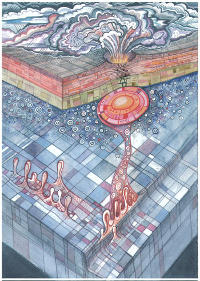River subbasins more depleted than
official figures show
09 April 2024
Published online 31 July 2016
This is how eruptions of supervolcanoes are controlled.

© Ivan Koulakov
Enlarge image
Ivan Koulakov and colleagues, including scientists from Saudi Arabia, present a fresh seismic model, based on studying magma paths beneath the Toba volcano in Indonesia, which last erupted some 74,000 years ago. The model explains why the magma system under Toba causes large, devastating eruptions, and how such large volumes of magma are generated1.
Studying seismic anomalies in the crust of the volcano and uppermost mantle in addition to the distribution of seismic events, the scientists were able to collect information about the multi-level structure of magma reservoirs responsible for feeding the supervolcano.
“We have discovered a low-velocity anomaly just below the crust that might be associated with a huge basic magma reservoir,” says Koulakov. “However, this mantle reservoir cannot directly feed the supervolcano because it is composed of dense basic material, which cannot ascend through the crust. Furthermore, we know that the products of the previous eruptions of Toba were entirely composed of the upper crustal rocks.”
That’s why the scientists propose that this mantle reservoir — effectively a complex, multilevel magmatic plumbing system — serves as a huge heater and is a source of overheated water, which can easily penetrate through the crust. It melts the "granitic" rocks in the upper crust and forms reservoirs highly saturated with fluids.
“When the amount of fluids exceeds a critical point, the liquid phase start boiling and causes an avalanche-type of process resulting in explosion and supereruption,” adds the lead author.
doi:10.1038/nmiddleeast.2016.116
Stay connected: